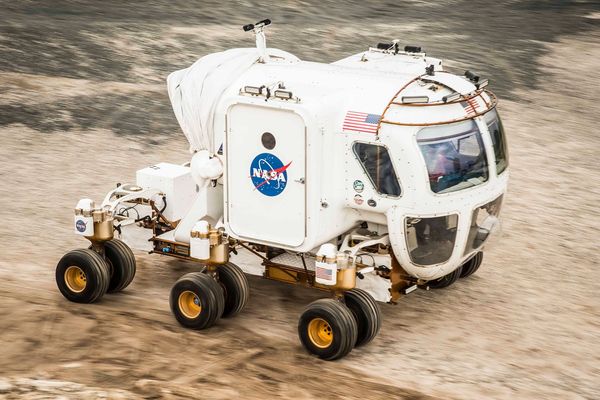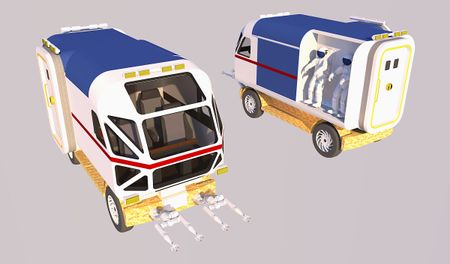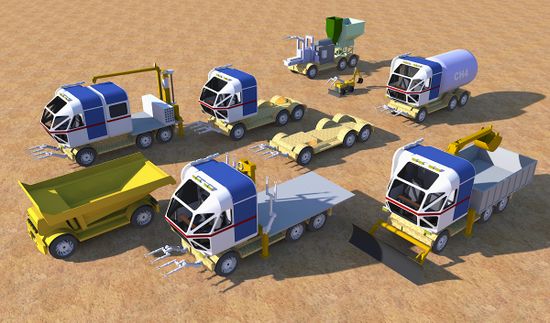Difference between revisions of "Rover"
(Improved the Planned Mars Rovers Section, added Mars 2020 and added some references.) |
|||
| Line 12: | Line 12: | ||
==Planned Mars rovers== | ==Planned Mars rovers== | ||
| − | *[[ExoMars]] | + | *The [[ExoMars]] rover by [[European Space Agency (ESA)|ESA]] has been named after Rosalind Franklin<ref>[https://www.esa.int/Our_Activities/Human_and_Robotic_Exploration/Exploration/ExoMars/ESA_s_Mars_rover_has_a_name_Rosalind_Franklin "ESA's Mars Rover Has a Name - Rosalind Franklin"] Press release about ExoMars naming.</ref>. The plan is to launch in July 2020<ref>[http://www.esa.int/For_Media/Press_Releases/Second_ExoMars_mission_moves_to_next_launch_opportunity_in_2020 "Second ExoMars mission moves to next launch opportunity in 2020"] (Press release). European Space Agency. 2 May 2016. Retrieved 2 May 2016.</ref> |
| + | *The [[Mars 2020]] rover is in build and test phase, with launch planned for the summer of 2020, and landing on Feb 18, 2021.<ref>https://mars.nasa.gov/mars2020/ Mars 2020 mission homepage.</ref> | ||
*The [[Beaver]] rover is planned as part of the Canadian [[Northern Light]] mission. | *The [[Beaver]] rover is planned as part of the Canadian [[Northern Light]] mission. | ||
| Line 20: | Line 21: | ||
The [[w:Space_Exploration_Vehicle|SEV]] is a planned manned rover that was tested by NASA form 2009 to 2013<ref>https://ntrs.nasa.gov/archive/nasa/casi.ntrs.nasa.gov/20140004223.pdf</ref>. Full scale prototypes were built and tested. The MMSEV (Multi Mission Space Exploration VEhicle) was a variant that could be used for space missions. | The [[w:Space_Exploration_Vehicle|SEV]] is a planned manned rover that was tested by NASA form 2009 to 2013<ref>https://ntrs.nasa.gov/archive/nasa/casi.ntrs.nasa.gov/20140004223.pdf</ref>. Full scale prototypes were built and tested. The MMSEV (Multi Mission Space Exploration VEhicle) was a variant that could be used for space missions. | ||
| − | ==Mars | + | ==Mars Manned Rovers== |
[[File:MMSEV5a.jpg|thumb|450x450px|A typical Mars Rover design. Solar cells provide emergency power, but the vehicle needs to be recharged as a power station.]] | [[File:MMSEV5a.jpg|thumb|450x450px|A typical Mars Rover design. Solar cells provide emergency power, but the vehicle needs to be recharged as a power station.]] | ||
Mars rovers cover a large variety of vehicles that have been developed for mission planning and Science Fiction movies. Most of the designs are close to what the SEV proposes. Rovers could be automated or carry passengers. | Mars rovers cover a large variety of vehicles that have been developed for mission planning and Science Fiction movies. Most of the designs are close to what the SEV proposes. Rovers could be automated or carry passengers. | ||
Revision as of 02:51, 17 September 2019
The term Rover as used here describes any all-terrain vehicle designed to traverse the surface of a planet, moon, or asteroid. It allows exploring the surface on a variety of places, collecting and examining Minerals, taking photos. The first rover (Lunokhod 1) was unmanned and remote controlled on Earth's Moon in 1970. During the Apollo missions in the 1970s rovers have been used manned to extend the exploration range of the crew. It was not until 1997 that the first rover landed successfully on Mars.
A martian settlement would require a number of rovers for transportation, exploration and various construction functions.
Contents
Successful Mars rovers
- Sojourner (1997)
- Spirit (2004)
- Opportunity (2004)
- Curiosity (2012)
Planned Mars rovers
- The ExoMars rover by ESA has been named after Rosalind Franklin[1]. The plan is to launch in July 2020[2]
- The Mars 2020 rover is in build and test phase, with launch planned for the summer of 2020, and landing on Feb 18, 2021.[3]
- The Beaver rover is planned as part of the Canadian Northern Light mission.
Space Exploration Vehicle (SEV)
The SEV is a planned manned rover that was tested by NASA form 2009 to 2013[4]. Full scale prototypes were built and tested. The MMSEV (Multi Mission Space Exploration VEhicle) was a variant that could be used for space missions.
Mars Manned Rovers
Mars rovers cover a large variety of vehicles that have been developed for mission planning and Science Fiction movies. Most of the designs are close to what the SEV proposes. Rovers could be automated or carry passengers.
A typical specification might call for a pressurized cabin, large windows, external manipulator arms, back entry suits and suit-ports as well as full sized docking ports. Wheels on Mars need to be designed for the very low temperatures.
Radiation protection could use water or ice in a double walled hull. Electrical power might come from a 50-200 kWh rechargeable battery back.
A base platform could be modified to provide specialised functions such as a crane, an exploration vehicle, a semi or an ore hauler.
Life support
A manned vehicle needs to maintain adequate air quality and interior temperature. It is likely that life support systems used in spaceships will be adapted for the rovers. Heat loss may be a significant issue during Martian nights, and the energy balance of the vehicle needs to be studied. Ideally, the material used for radiation protection would also be a good insulator.
Radiation protection
Radiation protection on a rover is limited, due to space and mass constraints. Frozen water was suggested as a good material for the SEV, in double walls. Plastic materials would be better than aluminium or steel in regards to high Energy cosmic radiation. Solar storm warning would be helpful to ensure occupants could reach a shelter in case of a large scale radiation event.
Power
The are two possible power sources for a Mars rover: Batteries and fuel. Batteries have the advantage of having a long history in vehicle power, and are used more and more frequently on Earth. They can also be recharged by on board solar panels, such as demonstrated in the novel and movie 'The Martian'.
Fuel, probably the same fuel as for the spaceships going to Mars, is another possibility. The mass ratio is better than for batteries, although reduced because the vehicle also needs to carry the oxygen for combustion. As both fuel and batteries have the same ultimate power source, be it solar or nuclear, conversion efficiency also comes into play in the overall analysis.
Wheels
Wheels and suspensions are a significant challenge for a Mars rover. The extreme cold of Martian nights and winters can reach the glass transition phase of most materials. This makes the wheel materials brittle and destroys them. A possible solution is solid metallic wheel, as for the Curiosity Rover. Alternatively, wire wheels were used successfully by the Apollo Moon Rover, and have recently been re-developed by NASA[5].
References
- ↑ "ESA's Mars Rover Has a Name - Rosalind Franklin" Press release about ExoMars naming.
- ↑ "Second ExoMars mission moves to next launch opportunity in 2020" (Press release). European Space Agency. 2 May 2016. Retrieved 2 May 2016.
- ↑ https://mars.nasa.gov/mars2020/ Mars 2020 mission homepage.
- ↑ https://ntrs.nasa.gov/archive/nasa/casi.ntrs.nasa.gov/20140004223.pdf
- ↑ https://www.nasa.gov/specials/wheels/









